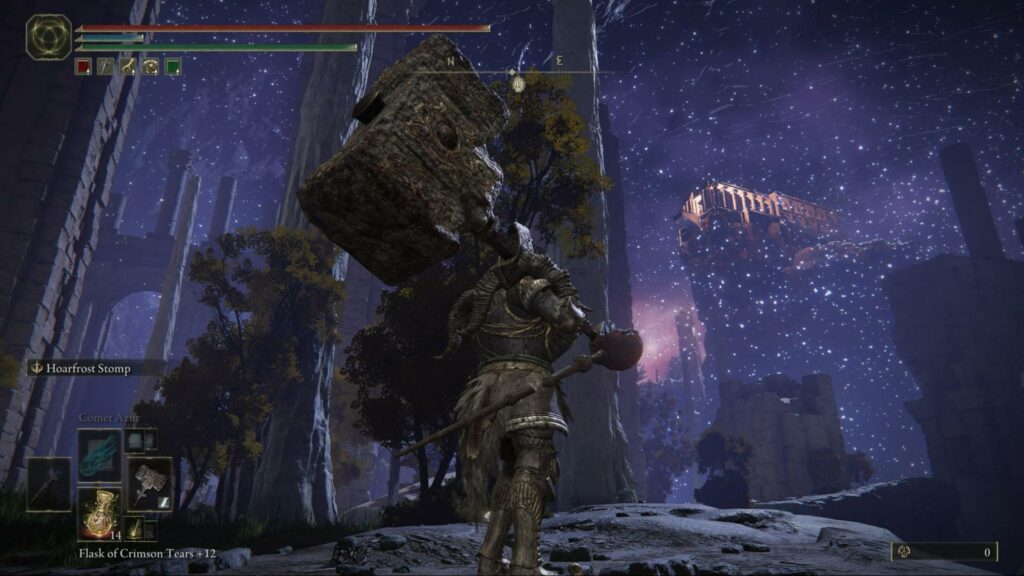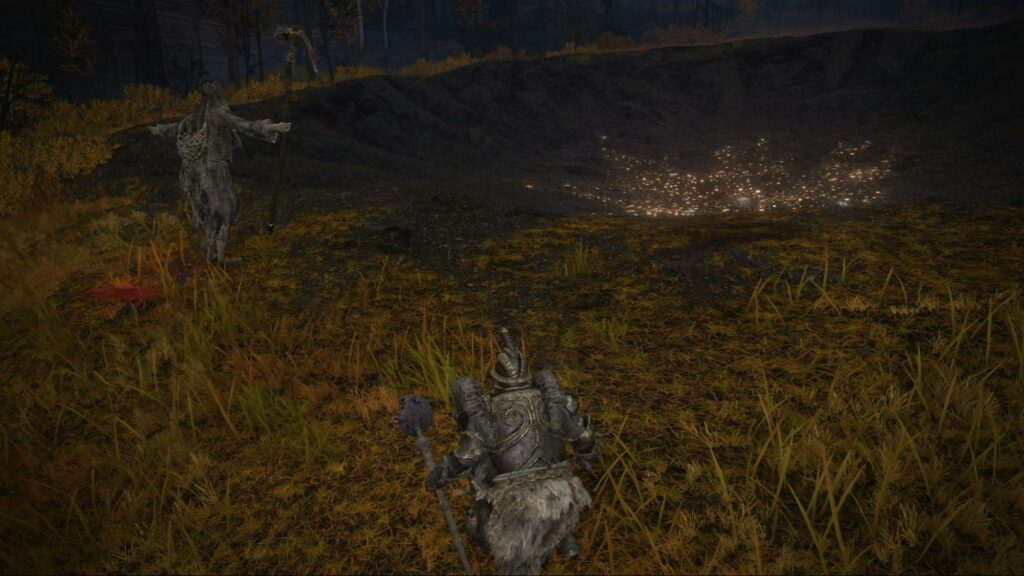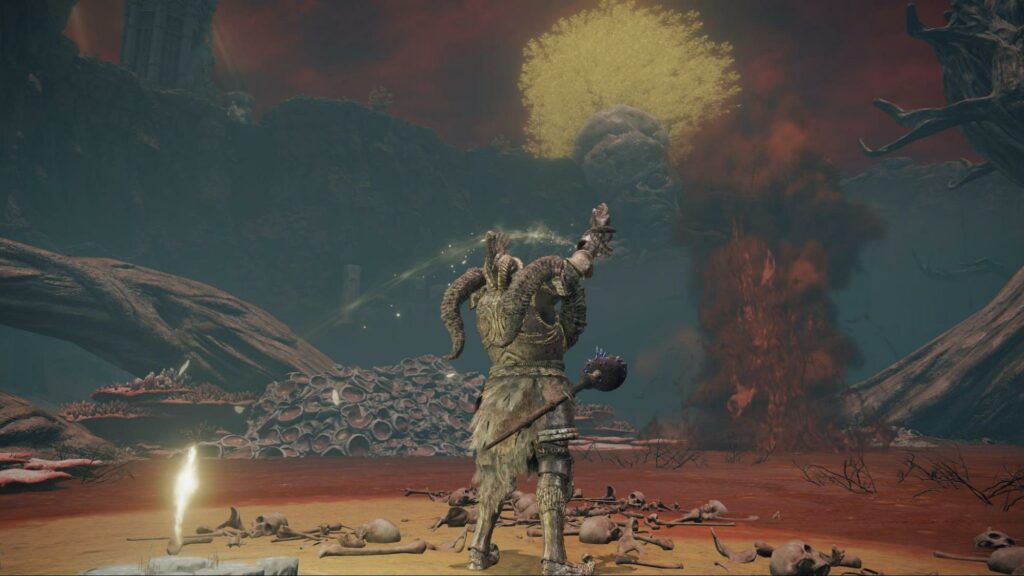A funny thing is happening in the wake of all the coverage Elden Ring has been getting: it’s revealing that a lot of the core appeal of the game doesn’t actually have to do with the infamously overhyped difficulty of the other games by developer FromSoftware (like Dark Souls, Bloodborne, and Sekiro).
It’s not just about “banging my head against a wall with a scary monster drawn on it,” as Ben “Yahtzee” Croshaw put it in 2015 when reviewing Bloodborne. There’s something else going on here. And it’s this:
At its heart, Elden Ring is about exploration.
And not in some abstract, “well technically” kinda way—in a very immediate and rewarding way.
Now, full disclosure: I’ve been a fan of these games since my love-hate relationship with the original Dark Souls tipped towards “love” and stayed there back in 2011. And yes, I know full well that people see all the cringey “git gud” memes and “prepare to die” marketing, and think fans like me look like the gamer equivalent of the Addams Family—weirdos who enjoy things exactly for being the opposite of what they’re supposed to enjoy.
So don’t take my word for it. Listen to the new players.
I have about half a dozen friends who picked up Elden Ring without ever having played any of FromSoftware’s previous titles. None of them considered themselves fans of the genre before, and they span a wide range of gamer profiles from “I’m writing a term paper about Gone Home” to “I prefer twitchy, fast-paced competitive shooters like Overwatch” to “My favorite ‘video game’ is the digital version of Agricola.” The only other game we all have in common is Magic (where, of course, we all prefer different decks and formats).
Not only do they all still enjoy Elden Ring—but all of them named one thing in particular that they really liked about it: exploration.
They like feeling smart for finding non-obvious routes to places.
They like poking around in all the game’s nooks and crannies and seeing what’s there.
They like seeing an item on a ledge somewhere that looks inaccessible, and trying to figure out how to get there.
These are the sort of things that FromSoftware games have been good at for a while now. The original Dark Souls was particularly lauded for its “interconnected world,” which might be better described as a “traversable world”—by which I mean, each time you see a place, you can go there.

See that pool of lava? That’s not just a skybox texture—you can go there.
Elden Ring takes that design philosophy and cranks it up to 11.
Whereas the many locations of Dark Souls were mostly stacked on top of each other vertically, in classic Metroidvania style, Elden Ring’s geography is spread out much more horizontally. That allows the player to spot more points of interest from farther away, and then start trying to figure out a path to get there. There’s no “objective marker” or minimap giving you homework assignments for where to go next until the game finishes reciting its prefabricated story at you.
This amount of openness also provides some relief from bashing your head against some of the game’s more challenging bosses, to a much greater degree than in other FromSoftware titles. Bloodborne is an excellent game, but its first main boss is no slouch—and you have to beat it to get to the rest of the game. Very few of Elden Ring’s bosses gatekeep progress like that; you can often just go somewhere else.
In fact, I’ve seen a lot of players (myself included) struggle a bunch with some particular bosses early in the game, be pushed towards exploring other areas as a result, and end up escaping the frustration that way until we can come back with bigger numbers on our stats and gear (and maybe a better understanding of the game’s mechanics). This is a deliberate lesson being taught by the game’s developers—the game wants you to be free to find the fun.

See that temple off in the starfield that looks straight outta Theros? You can go there.
And there’s lots to find. I spent over a hundred hours on my first playthrough trying to uncover as many things as I could, and I still missed a bunch of stuff in the starting area that my boyfriend found just within the first few hours of his run.
Even the map itself adds to the fun of exploration in this game. Unlike other open world games, whose maps basically get turned into checklists by the sheer volume of markers and “here’s where everything is” legends on them, Elden Ring features a fairly simple hand-drawn map without any legend or key at all. It lists places of interest (that you’ve been to), places you can warp to, and that’s about it. Figuring out that a particular drawn symbol means there’s a cave there, or that the map is sometimes incorrect and there’s additional secrets to be found, are exciting and motivating moments.
And on top of that, Elden Ring hides its map under a fog of war that obscures just how big it really is. You can stumble into a booby-trapped treasure chest that teleports you to a cave full of crystals and bug wizards, only to escape and look up at a blood-red sky before opening your map and seeing that it’s doubled in size to account for how far away you got sent. The game has a way of unfolding as you progress that makes it seem bigger than it really is.
Found a message that said "Why is it always just getting started" at the start of the seventh Elden Ring area I assumed was the final area. Convinced at this point the game may just never end.
— Jacob Geller (@yacobg42) March 3, 2022
And Elden Ring is indeed huge—but I need to unpack that a bit. At a time when AAA developers are climbing over each other to boast about playtimes that demand the equivalent of multiple full-time jobs from you, Elden Ring is huge in a different way: it’s not so much long as it is deep.
There have been a lot of comparisons between Elden Ring and Breath of the Wild arising purely from the fact that both are successful open-world RPGs, but the two games actually do share some structural similarities (and Elden Ring’s director, Hidetaka Miyazaki, cited Breath of the Wild as an aspirational influence).
Both games have a pretty short list of “major dungeons”—in Breath of the Wild, it’s the four divine beasts and Hyrule castle; in Elden Ring, there’s seven “legacy dungeons” (to use a fan term), of which 2-4 are optional. The rest of the traditional “levels” are in bite-sized pockets scattered throughout the map—as shrines in Breath of the Wild, and as the various catacombs, tunnels, and tombs in Elden Ring.
Unlike open world titles by other developers such as Bethesda, CD Projekt Red, and Ubisoft, both Breath of the Wild and Elden Ring give the player a lot more freedom to decide how deep they want to go down their many rabbit holes. Where a game like The Witcher 3 has a lengthy main quest that is designed to lead you through every major area and character, Elden Ring’s content is much more à la carte. There are well over 150 boss encounters in Elden Ring, but only about a dozen of them are necessary to beat the game. It’s your own appetite that’s at the wheel.
This is really exemplified by the game’s approach to its story.
The plot of Elden Ring is very simple: someone broke a divine ring and a bunch of demigods claimed its power for themselves, so you beat enough of them up to get strong enough to declare yourself the new ruler of this war-torn land.
Beneath that, though, there’s a sprawling, layered tapestry of lore—demigods and outer gods and aliens, detailed genealogies for each competing pantheon, debates between scholarly traditions, dozens of different types of magic, histories of marriages of power and betrayals. It’s easy to see the plentiful fruits of FromSoftware’s collaboration with George R. R. Martin if you look for it.

I just really wanted an excuse to include this image here. It’s amazing.
But that’s the key: if you look for it.
Again, Elden Ring’s approach to lore is pretty different from the titles put out by other developers. Cyberpunk 2077 has frequent lengthy cutscenes where characters soliloquize about the world around you. Skyrim has hundreds of in-game books detailing its history. Witcher 3 has both, and literal encyclopedia entries about each character and type of monster in the game.
Elden Ring doesn’t have any of that. There’s no several-minute-long dialog-heavy cutscene where a sanctimonious old dude explains to you the etymology for one third of how dragons say “shove” as part of an extended plot dump about how it takes normal people years of study to learn this shit but the main character is special because blah blah blah you’ve already tuned out of this sentence that’s just summarizing that moment.

I’ll stop taking potshots at Skyrim when they stop re-releasing it.
Instead, Elden Ring has a few short exchanges with its relatively small cast of non-player characters, and then a couple sentences of description for each item in the game, and that’s it. You can play through the whole game without ever needing to know what “Tarnished” means and why people call you it all the time.
But, if you want, you can dig a little deeper.
Through little snippets in item descriptions and observations during gameplay, Elden Ring gives you stars and invites you to draw the lines between them to make constellations.
There are tall, dark-skinned humanoids that wield strange gravity magic. You might wonder what their deal is, and then find people who seem to be worshiping these beings hanging out around craters. So you start looking for them, and then eventually find a creature in one of those craters that can natively manipulate gravity and whose name suggests it came from the cosmos, and start to piece together how an alien type of magic arrived in The Lands Between.

Did you just stumble onto the site where an entire religion was founded?
Or maybe you start to notice that all the adorable living jars in the game are full of flesh inside. What’s up with that? Then you find the ghost of someone who dreams of becoming the insides of a warrior jar, and you start to get an idea of what’s going on. But then, what does it mean that there are so many of these types of jars littered around holy trees?
Someone tells you that all the servants in a certain castle rebelled and killed their masters, and you notice that they’re all monsters—in fact, the same kind of monster as a friendly blacksmith who’s been improving your weapons. Didn’t he say he was a prisoner? What did he do? Do these crimes turn you into a monster, or is there something else going on here?
And what is it that those bat-like creatures with human heads are singing before they engage you in combat? Is that Latin?
If you want to explore all these things, then you can go there. You can turn over every rock and start scrutinizing the fascinating, squirming things underneath. And if you don’t want to, then the game doesn’t drag you through it—you can just keep making your numbers go up until you beat up the last big thing and see the credits roll. And then do it all again with a completely different character build, and see completely different things.
It’s all up to you.

Better to rule in hell . . .
This is what makes Elden Ring feel refreshing, despite all the times that a skeleton pops out of a corner to kick you into a bottomless pit or pack of wolves jumps onto you from out of the sky or whatever other goofy and unexpected way the game kills you with.
A lot of modern games recreate the suffocating attention economy of media in general these days—full of objective markers and blinking indicators, bursting with endless contextual prompts and calls to action, with quest logs as endless and unmanageable as your inbox.
Elden Ring just isn’t built like that. The entire game is an Easter egg hunt, and you’re a kid looking for hidden goodies. You can spend hundreds of hours playing and still discover new stuff you never knew was there—all without feeling overwhelmed by things to do.
Instead of loudly demanding your attention, it quietly rewards your investigation. There are no push notifications in The Lands Between.
You’re free.
Mani Cavalieri is a New York City-based writer, media critic, and your pale cousin who’s into reptiles. He publishes regular essays on media—from game reviews to gushing about how cool that weird Godzilla movie is—over on Eyez ‘n Teef (which you can also follow on Twitter, for all the trivia and toast recipes that don’t make it into full-length posts). He loves sharing cool things you didn’t know, and he WILL talk your ear off about them.



